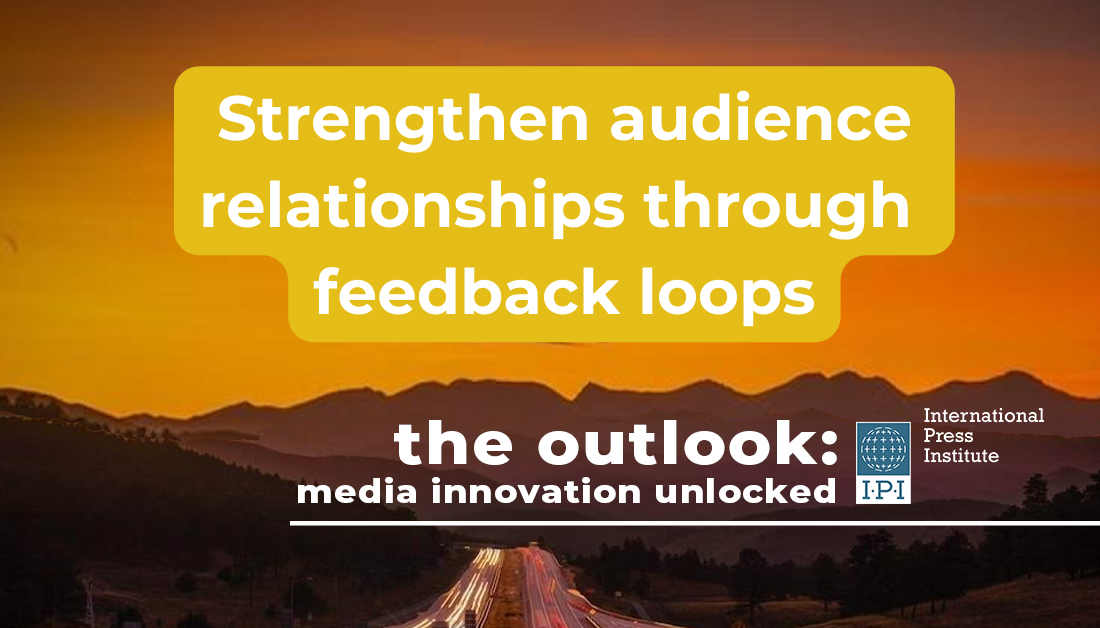This text comes from IPI’s newsletter The Outlook. Click here to sign up to receive future editions direct to your inbox.
In October, IPI brought together editors, founders and product professionals from the 10 media startups in our New Media Incubator. In this edition of The Outlook, IPI’s Media Innovation and Sustainability team takes you behind the scenes of one of the sessions.
Do you know someone who might enjoy The Outlook? Please send them this link and spread the word.
The challenge: Good intentions for audience strategy fall by the wayside
The teams in our New Media Incubator all share one challenge, and it’s one most media professionals can relate to: a lack of time.
In order to survive, you have to be strict with your priorities, and make sure that you are able to follow through on your strategy. Does your mission include goals like amplifying unheard voices or serving a specific community? To deliver on these promises, staff need a process that builds this into their daily work.
The solution: Think in terms of loops and cycles
Innovation is a continuous process, and iteration is key. This can apply to different parts of your newsroom; in the previous edition of The Outlook we looked at applying a design thinking approach to incorporating AI into your strategy.
The act-learn-build cycles of your product work will happen mostly ‘behind the scenes’ in the newsroom, but cycles and loops are also effective as part of your audience research and engagement – and these are cycles that your audience is directly involved in.
We introduced two methods for your media to start building this into your workflow: OKRs (there’s a previous edition of The Outlook about these) and feedback loops. Today, we’ll talk feedback loops.
IPI innovation trainer and engagement consultant Morten Ro introduced the New Media Incubator teams to this method of inviting audience participation.
Start by asking your audience a question, review the information they give you, and – this part is crucial – provide a response. The response might be a direct answer to their question in the form of an article, or it might also be making changes to your product or UX based on the feedback, but the important thing is that you tell the audience what you’re doing.
For example, you could ask the audience what questions they have about your local area, big or small, and answer these in an article or podcast. Your ask could be more specific – if there’s a local election coming up, try asking which questions they want to put to candidates, and then including these in your interviews. Make sure you let your audience know how their input shaped your work.
Then, repeat the process, inviting more input from your audience. You learn more and tweak your product with every round of the loop.
“When you are exhausted with yourself and with repeating things, that’s when things are starting to stick with your audience,” said Morten.
“It’s a long road from people who are not used to contributing, to people who are involved. You really want to nurture the dialogue. If you only do it rarely, you won’t get there.”
The Takeaway: You really want to get the first invite right, even though it might not lead to very much. The whole idea behind feedback loops is to repeat, repeat, repeat.
So, strike a balance between kicking off the cycle by getting your first step out there, but making sure this first step has a decent chance of success, based on your research and data. This means that you need to ask the audience to do something which you actually care about – something you can act upon and respond to.
News from IPI’s Media Sustainability Team
A big announcement from IPI: registration is now open for the IPI World Congress and Media Innovation Festival in 2024, which will take place in Sarajevo from May 22 to 24. The theme for next year is ‘Navigating Crises: Journalism at a Turning Point’ and we are working on putting together an insightful and diverse agenda on this topic. Register here.
Funding opportunities for media
- Journalists with at least five years of experience covering immigration and migration can apply for a one-week Kiplinger Fellowship, covering some travel, lodging and training in April 2024 at Ohio University and the Scripps School of Journalism.
- Interested in climate storytelling? Young journalists from across the Global South are invited to apply to the CNN Academy’s Rockefeller Foundation Program which includes expenses-paid in-person training in Abu Dhabi. The deadline is November 14.
- Internews’ Earth Journalism Network offers a fellowship which includes funding of €12,000 to cover time, story production, and professional development for journalists from low- or middle-income countries. The deadline is November 16.
- Climate Tracker has opened a new call for applications for its Climate Journalism Mentorship Program for journalists in Latin America. Successful applicants get funding of $750 and an eight-month program of training and mentorship; the deadline is November 19.
- Flashlight regularly offers grants of up to $1,000 for freelance investigative reporters based in the US. The current round has a November 19 deadline and you can apply here.
- Journalists based in countries with restricted press freedom are eligible to apply for a Reporters Without Borders fellowship for six months in Berlin. It’s another November 19 deadline, and the program offers “time off to recover from their difficult working conditions and to expand their personal and professional horizons”.
IPI’s media innovation and sustainability work is made possible with support from the European Union, Friedrich Naumann Foundation and ERSTE Foundation.

